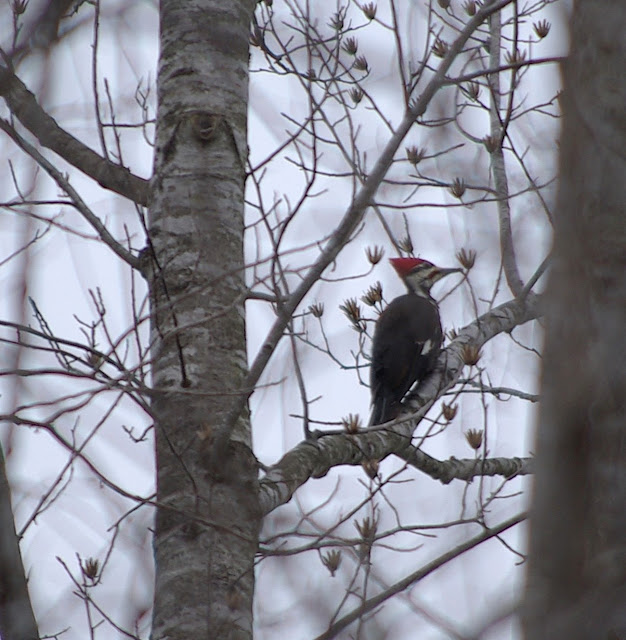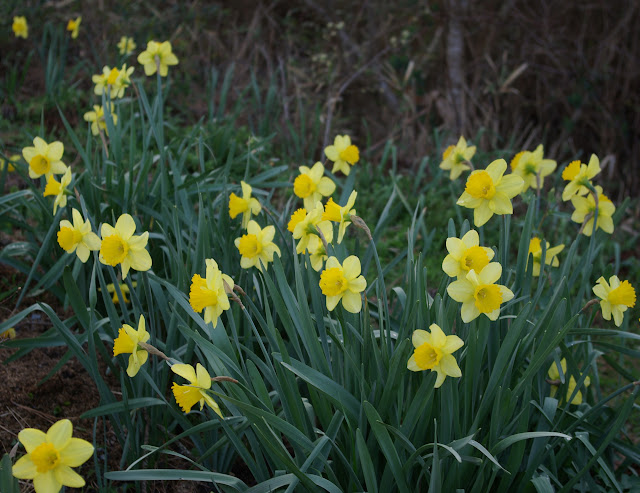We lost Prissy on the 13th. She had just turned 20 years old and she went as peacefully as possible. It's very painful anyway. We still have her brother Tommy and he looks bright and purrs all the time, but he has cardiovascular problems and arthritis.
I don't feel up to looking through her pictures, but I wanted to mention her because she was such a big part of my life and often kept me company while I worked in the garden and always cuddled with me on the couch. I love her and miss her so much.
*************************
For a brief moment I thought I had a name for Eva's daffodils when a commenter posted that they look like 'Sir Watkin' (which they do), and then I looked at the height listed for SW. It's over 2 feet tall. Not surprisingly it is also known as the giant daffodil. I'm having trouble even imagining a daffodil that tall. lol It would be nice to have a name, but so many daffodils have been introduced over the years that I don't even know where to start.
Eva herself may not have known the name of these daffodils because most of her plants were passalongs.
Spring looked as though it was going to arrive really early this year after some really warm weather in February, then temperatures cooled off again and the rate of spring moderated to something more reasonable. Still, I doubt I will get the garden cleaned up in time and that's OK. The garden will have shortcomings that I touched on in the last two posts and I have work to do to get the garden where I want it.
I may replace the Japanese beautyberries in these pictures. They look nice in the fall, but they don't fit in with the rest of the bed. They're still leafless while everyone else is going full whack. One winter the bluebirds went crazy over the fruit but that was 9 years ago. I think because there are so many fruiting shrubs in my garden they just don't seem to be interested in them anymore.
Eva's daffodils finished up about three weeks ago after blooming a month early but the other daffodils - 'Quail', 'Trevithivan', 'Sweet Love' and 'Thalia' started at the usual time and are in full bloom now.
Three other species of violets grow wild on the farm: marsh violets, early blue violets (which are not at all early), and a tiny white violet that's either white bog violet or primrose leaves violet. I've tried the first two in the garden and I couldn't make them happy. Marsh violets demand constant moisture. Early blue violets, like their cousins birdsfoot violets, need open space. I transplanted a single bunch of the white violets into the front garden so I'll see this year how they do. Blue violets, on the other hand, can form a carpet when they're happy, although the numbers I get can vary a lot from year to year. They've been blooming for over a month now.
It seems that this redbud and red maple have been blooming forever too, and the orchid purple and soft orange make a striking combination. In fact the red maple is blooming it's heart out so much that I'm wondering if this is its last hurrah. As you can see it's splitting down the middle. Funny enough there is one redbud up top that's blooming at the same time as this one, while two others on either side are just starting to open now.
It grows by a big ditch that originates south of the big bed, runs by the old house site, then turns and runs parallel to the horse pasture before continuing on to the neighbor's farm. There's a whole maze of these mini waterways going to the creek that borders our property. The holly's roots were undermined by all of the rain we got with Hurricane Floyd in 1999 and it fell over. But it survived, and several leaders have grown up. It was much more beautiful as a conical tree with a single leader but in a year with decent rainfall it fruits as heavily as ever. Most years in late winter flocks of robins and cedar waxwings descend upon it and strip its fruit. I happened to be down there cleaning up the bed by the gate when a flock of cedar waxwings were feeding. They were being a bit skittish but I got a few pictures.
I see and hear cedar waxwings often, well into the month of May. I usually see them as silhouettes though, flying from the tops of trees that are over 60' high. Ironically until last week the closest looks I'd gotten of cedar waxwings the past couple of years was at the grocery store when a bunch were feeding on the pear trees in the parking lot. No, Bradford pears are in fact not sterile. Bradford pears cannot breed with each other, but they can breed with other pear trees. I can attest to this as seedlings are now popping up all over my farm.
Of course, mockingbirds love the fruit too, and one of the resident mockingbirds spends most of the winter lording over it.
I finally got a couple of pictures of a pileated woodpecker! I see them often, as they like to feed in the tulip poplar stand above the house (where these pictures were taken), and in summer I frequently see them flying back and forth across their large territories.
He felt comfortable enough to do a bit of preening. The horses were probably still in the paddock behind the house. Wildlife isn't nearly as alarmed if I am near the horses.
I know a lot of birds will be happy if I am slow to get the garden cleared up. There are throngs of song sparrows and white-throated sparrows here each winter and they love the cover.
The red-shouldered hawks are nesting near the house again. This past week one of them surprised me the other day by landing on something (cotton rat?) about 15 feet away from me while I was working in the garden. The hawk looked a little surprised too. I think he or she was so focused on the prey that they didn't notice me.



























































































